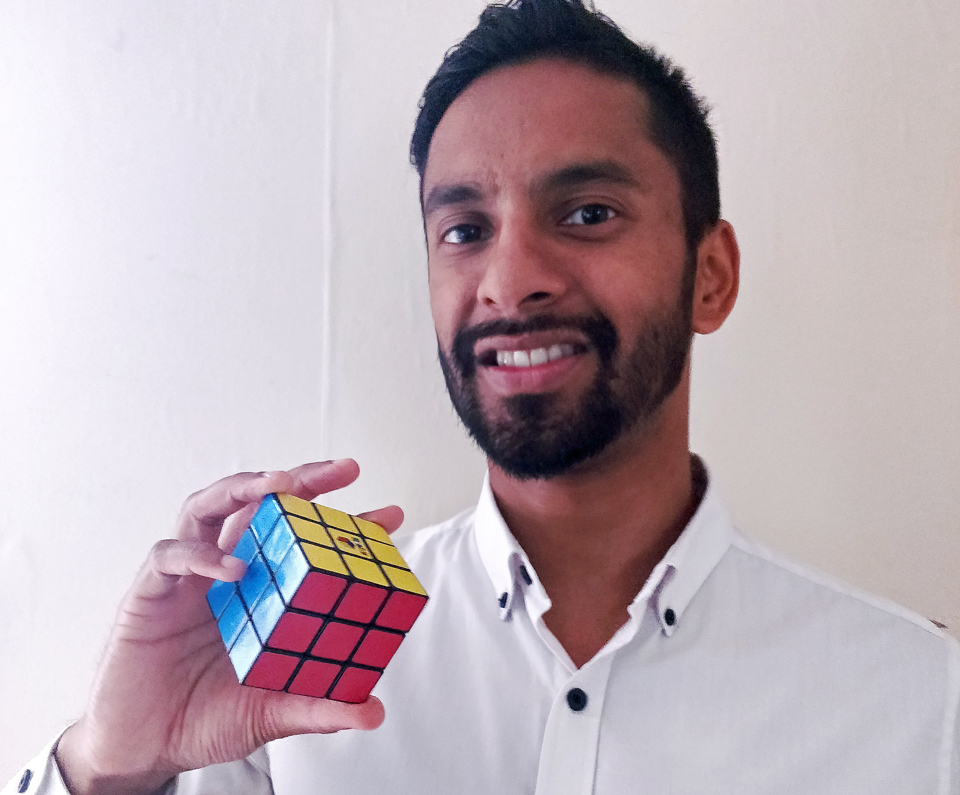Bobby Seagull needs your help.
This maths teacher and TV maths educator; University Challenge alumnus; presenter of Monkman and Seagull’s Genius Guide to Britain (a new series is due back on our screens this autumn); puzzle setter extremo and Potential Plus UK Ambassador has taken on a summer challenge…
“One of my projects over the summer is to try and learn how to solve a Rubik’s Cube. As a child, I sometimes struggled with this and solved it in a long-winded manner. But I’d love to hear from you on any tips you might have so I can learn a proper method to solve them, and then get quicker. You’ll be helping Mr Seagull against some of my school students who can solve Rubik’s Cubes quite quickly!” [Bobby Seagull]
What tips would you give Bobby to speedily solve his Rubik’s Cube Dilemma? Email them by August 30th to Focus@potentialplusuk.org and we’ll pass them on to Bobby to see how he gets on!
Rubik’s Cube Fact File
- Rubik’s Cube is a 3D 3x3x3 combination puzzle made up of twenty-six miniature cubes twisting around a central pivot.
- There are 43 quintillion possible combinations – and one solution to the Rubik’s Cube.
- The Cube was invented in 1974 by Hungarian sculptor and professor of architecture Ernő Rubik.
- To solve a Rubik’s cube each of its six sides must be twisted into a single colour of 9 squares: white, red, blue, orange, green, and yellow. When the cube was originally launched the colours were stickers – leading to a little judicious cheating by peeling them off a square and moving them if a person couldn’t work out how to solve the cube!
- Speedcubing/Speedsolving involves solving a variety of twisting puzzles including the Rubik’s Cube.
- The World Cube Association regulates and holds competitions for twisty puzzles. Up to February 2019, more than 118,000 people from around the world have participated in World Cube Association competitions.
- Tim Wong holds the record for independently completing a Rubik’s Cube in the fewest moves – only 19! – in 2015. This was later equalled by Marcel Peters, in 2016. The average number of moves to solve a Rubik’s Cube is 50.
- Yusheng Du currently holds the record for solving the Rubik’s Cube with two hands in 3.47 seconds. https://youtu.be/SB3ut65SFUU
- Feliks Zemdegs holds the record for the fastest one-handed solve of 6.88 seconds https://youtu.be/3FDmmL5vKHg
- Daniel Rose-Levine holds the record for solving the Cube with his feet in 16.96 seconds (example of him solving the cube with his feet https://youtu.be/-qY_Po-RTOE )
Humans aren’t the only ones solving Rubik’s Cubes.
In 2019 DeepCubeA – an artificial intelligence neural network – which mimics how the human brain works – taught itself to solve the Rubik’s Cube in 1.2 seconds. While not as fast as min2phase (see below), min2phase was a purely mechanical algorithm dedicated to solving the cube only. DeepCubeA is a great development for artificial intelligence, as a machine reasoning and learning for itself, this offers the potential of applying that reasoning to other problems. (algorithm: https://codeocean.com/capsule/5723040/tree/v1 ) Read more about its success at: https://www.bbc.co.uk/news/technology-49003996
In 2018 the record for a robot solving a Rubik’s Cube was created by MIT students Ben Katz and Jared Di Carlo – the min2phase algorithm (algorithm: https://github.com/cs0x7f/min2phase ) solved the 3x3x3 cube in 0.38 seconds!
If, like Bobby, you are trying to work out how to solve Rubik’s Cube, take comfort that it took its inventor, Ernő Rubik, a month to solve it – and if all else fails, there is a guide to how to solve a 3x3x3 cube on the official Rubik website https://www.rubiks.com/solution-guides
About the Author: Geraldine Glover is Potential Plus UK’s Community Information Coordinator. She is a Chartered Information Professional with a background in editorial work and information science. She is the mother of two children with high learning potential.






